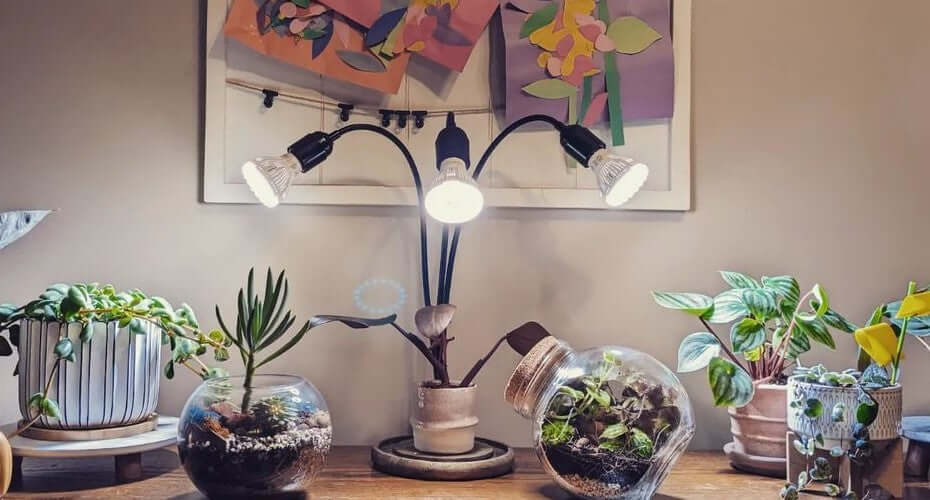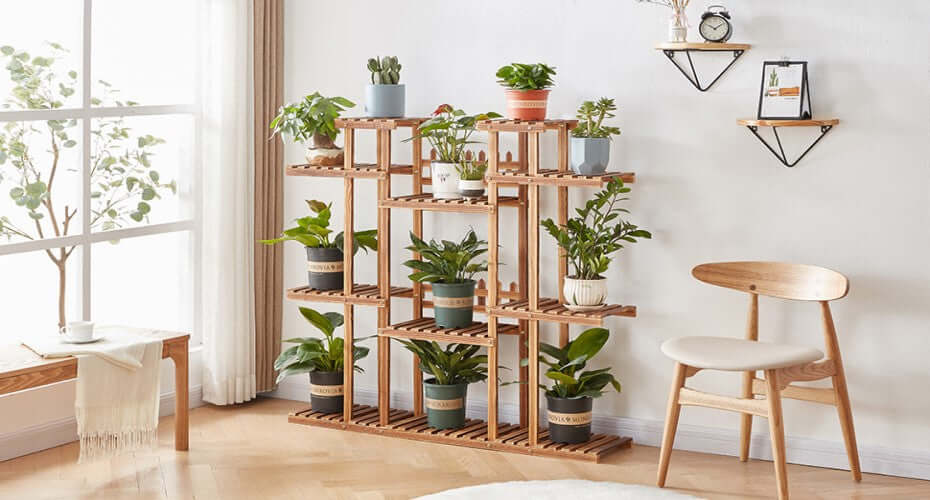Some common indoor plants such as Boston Ferns, Spider Plants, Peace Lilies, and Succulents are not very tolerant of cold environments. How do we maximize our plants' autumn bliss? Here's some tips.

First, place these cold-sensitive plants in an indoor location with a temperature between 15-24 degrees Celsius. Avoid exposing them to excessively cold or hot environments.
Second, during the winter, plants may face issues with inadequate light. Generally, plants require 12-16 hours of light per day for photosynthesis, but natural daylight hours are shorter. In such cases, consider using LED grow lights to provide additional illumination.

But how do you choose the right plant grow light for your home?
Opt for Full Spectrum LED Plant Grow Lights
Full spectrum grow lights provide the complete range of light required by plants, including visible light as well as a portion of ultraviolet and infrared light. Compared to red and blue spectrum grow lights, full spectrum lights closely mimic natural sunlight, resulting in less eye strain and making them more suitable for home environments.
Here introduce SANSI LED Clip-on Plant Grow Light. It is designed with a full spectrum of light, catering to the needs of plants in different growth stages. Its wide wavelength range allows it to adapt to various growth requirements. Additionally, the light has a high Color Rendering Index (CRI) of 95, ensuring vibrant and natural colors, providing ample light while enhancing aesthetics.

|
Spectral proportion |
Wavelength coverage |
The role of the spectrum |
Stage |
|
Blue light-18.00% |
400-499nm |
Blue light aids in promoting photosynthesis, stimulating plant germination, and influencing plant morphology and structure. |
Germination |
|
Green light- 33.10% |
500-599nm |
It fosters stem and leaf growth, increases chlorophyll synthesis, and enhances light energy utilization efficiency. |
Growing |
|
Yellow light-40.42% |
600-699nm |
It plays a crucial role in regulating the flowering and fruiting processes of plants. |
Flowering |
|
Far-red light -8.48% |
700-780nm |
It can promote fruit development, regulate fruit quality, and delay fruit aging, serving as a regulatory factor. |
Fruiting |
How Does SANSI Achieve Low Power Consumption and High Efficiency?
SANSI LED Plant Grow Lights utilize high-efficiency LED chips that consume less power while delivering exceptional brightness. Furthermore, they feature advanced ceramic heat dissipation technology, quickly dissipating heat to prevent LED chip overheating, reducing light degradation, and extending the product's lifespan. The high-quality lens concentrates light, improving light utilization and photosynthesis rates for enhanced plant growth. With a high PPF (Photosynthetic Photon Flux) and a PPFD (Photosynthetic Photon Flux Density), these lights provide optimal conditions for plants.
Why is Ceramic Heat Dissipation in LED Plant Grow Lights More Reliable?
Temperature significantly affects the lifespan of LED chips. Effective heat dissipation is crucial for LED grow lights' efficiency and longevity. SANSI LED Plant Grow Lights employ ceramic heat dissipation technology, where LED chips are directly bonded to ceramic, allowing for efficient heat dissipation through air convection. Compared to traditional aluminum substrate designs, ceramic technology offers rapid heat dissipation, slower light degradation, and longer lifespan. Ceramic is an insulator, making it safer, eliminating the need for fans. Moreover, SANSI LED Plant Grow Lights are ETL certified and quality-tested, with a reliable lifespan of 25,000 hours. They are a trustworthy choice for your indoor gardening needs.
Setting the Angle and Height for SANSI LED Plant Grow Lights
Plant growth and development are closely linked to PPFD (Photosynthetic Photon Flux Density). PPFD accurately measures the light energy provided by a light source for photosynthesis. Different plants have varying PPFD requirements; some need higher PPFD to thrive.
The distance between the light source and the plant is a critical factor influencing PPFD. The closer the light source to the plant, the higher the light intensity (PPFD); conversely, a greater distance results in lower light intensity (PPFD). This is because light undergoes attenuation and scattering as it propagates.
|
Seedling Stage |
Large Plants |
|
For small plants or seedlings, placing the light source closer provides higher light intensit. |
For large plants or mature ones, positioning the light source farther away achieves a more even distribution of light. |
SANSI LED Plant Grow Lights feature a 360° flexible gooseneck and a simple A-shaped clamp, making it easy to clip them onto shelves, pots, tables, and various other locations. Compared to floor-standing plant grow lights, they are lightweight and do not harm the roots.
Example: PPFD Reference for SANSI 20W Clip-on LED Plant Grow Lights:

|
Light Source Height |
Supplemental Light Coverage Area |
PPFD |
|
1ft |
0.41㎡ |
195.82 umol/m²/s |
|
2ft |
2.12㎡ |
48.96 umol/m²/s |
|
3ft |
10.63㎡ |
21.76 umol/m²/s |
|
4ft |
33.37㎡ |
12.24 umol/m²/s |
SANSI, with over 20 years of industry experience, is a lighting company that focuses on ceramic heat dissipation technology, providing customers with high-quality lighting products and lighting solutions. For more information about SANSI's services, feel free to contact us
The Grow Light Mention on the Blog
30% OFF(Time limited) 20W Adjustable 2-Head Clip-on LED Grow Light
Looking for more growing knowledge? Click these blogs:
Unveiling the Advantages of SANSI LED Clip-on Grow Lamps
Full Guide – How to Choose the Right LED Grow Light for Indoor Plants
How Can A Full Spectrum Grow Light Affect Your Plants Grow?



